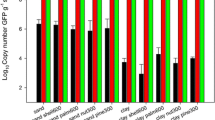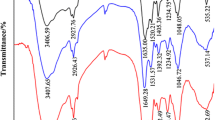Abstract
Several studies have investigated the adsorption of pure DNA on soil particles and its transformation ability. However, the presence of not purified (dirty) rather than pure DNA is more common in the extracellular soil environment. For this reason, we have investigated the adsorption and binding of dirty DNA on montmorillonite (M) and kaolinite (K) and their transforming ability in comparison to pure DNA. After lysis of Bacillus subtilis cells, induced by KCl, dirty DNA was characterized by the presence of cellular wall debris (cwd) and other constitutional organic components (coc). The dirty DNA was then divided into two fractions, one with cellular wall debris (DNA +cwd) and the other without cellular wall debris (DNA −cwd). B. subtilis BD 1512 (Cmr) and BD 170 (Cms) were selected as donor and recipient bacteria, respectively, for adsorption and transformation studies. Both cwd and coc seem to facilitate the adsorption of DNA to clay minerals, whereas only cwd promote the DNA binding on clays, protecting also the DNA fragments below 400 bp against nucleases. Both dirty DNA fractions adsorbed and bound on clay minerals were able to transform competent cells.




Similar content being viewed by others
References
Bloomfield V (1998) DNA condensation by multivalent cations. Biopolymers 44:269–282
Castro M, Erhardt M, Chen R, Castro J (1995) Significance of 260/280 nm absorbance ratios for oligonucleotide primers in HLA DNA typing. Hum Immunol 44:143
Ceccherini MT, Ascher J, Pietramellara G, Vogel T, Nannipieri P (2007) Vertical advection of extracellular DNA by water capillarity in soil columns. Soil Biol and Biochem 39:158–163
Crecchio C, Stotzky G (1998) Binding of DNA on humic acids: effect on transformation of B. subtilis and resistance to DNase. Soil Biol Biochem 30:1061–1067
Crecchio C, Ruggiero P, Curci M, Colombo C, Palumbo G, Stotzky G (2005) Binding of DNA from Bacillus subtilis on montmorillonite–humic acids–aluminum or iron hydroxypolymers: effects on transformation and protection against DNase. Soil Sci Soc Am J 69:834–841
Demanèche S, Jocteur-Monrozier L, Quiquampoix H, Simonet P (2001) Evaluation of biological and physical protection against nuclease degradation of clay-bound plasmid DNA. Appl Environ Microbiol 67:293–299
Ding X, Henrichs M (2002) Adsorption and desorption of proteins and polyamino acids by clay minerals and marine sediments. Mar Chem 77:225–237
Dubnau D, Davidoff-Abelson R (1971) Fate of transforming DNA following uptake by competent B. subtilis. J Mol Biol 56:209–221
Escriba PV, Ozaita A, Ribas C, Miralles A, Fodor E, Farkas T, Garcia-Sevilla JA (1997) Role of lipid polymorphism in G-protein–membrane interactions: nonlamellar-prone phospholipids and peripheral protein binding to membrane. Proc Natl Acad Sci USA 94:11375–11380
Fang Y, Hoh J (1998) Early intermediates in spermidine induced DNA condensation on the surface of mica. J Am Chem Soc 120:8903–8909
Fusi P, Ristori G, Calamai L, Stotzky G (1989) Adsorption and binding of protein on “clean” (homoionic) and “dirty” (coated with Fe oxyhydroxides) montmorillonite, illite and kaolinite. Soil Biol Biochem 21:911–920
Gallori E, Bazzicalupo M, Dal Canto L, Fani R, Nannipieri P, Vettori C, Stotzky G (1994) Transformation of B. subtilis by DNA bound on clay in nonsterile soil. FEMS Microbiol Ecol 15:119–126
Glasel J (1995) Validity of Nucleic acid purities monitored by 260/280 nm absorbance ratios. Biotechniques 18:62–63
Griffith J, Makhov A, Santiago-Lara L, Setlow P (1994) Electron microscopy studies of the interaction between a B. subtilis a/ß type small, acid-soluble spore protein with DNA: protein binding is cooperative, stiffens the DNA, and induces negative supercoiling. Proc Natl Acad Sci USA 91:8224–8228
Gurlie R, Zakrzewska K (2000) Protein induced DNA bending: the role of phosphate neutralization. In Proc. of Conference on DNA structure and interactions. Mendel-Brno 2000. Academy of Sciences of the Czech Republic, Institute of Biophysics, Brno Masaryk University, 19–23 June, Brno Czech Rep. 17
Harlow E, Lane D (1988) Protein quantitation–UV detection antibodies: a laboratory manual, Academic, New York, USA p 673
Khanna M, Stotzky G (1992) Transformation of B. subtilis by DNA bound on montmorillonite and effect of DNase on the transformation ability of bound DNA. Appl Environ Microbiol 58:1930–1939
Khanna M, Yoder M, Calamai L, Stotzky G (1998) X-ray diffractometry and electron microscopy of DNA from B. subtilis on clay minerals. Sci Soils 3:1
Kim RS, LaBella FS (1987) Comparison of analytical methods for monitoring autoxidation profiles of authentic lipids. J Lipid Res 28:1110–1117
Koltover I, Wagner K, Safina CR (2000) DNA condensation in two dimensions. Proc Natl Acad Sci USA 97:14046–14051
Liu C, Smith M, Ajito K, Komatsu H, Gomez-Paloma L, Li T, Theodorakis EA, Nicolau KC, Vogt PK (1996) Sequence selective carbohydrate–DNA interaction: dimeric and monomeric forms of the calicheamicin oligosaccharide interfere with transcription factor function. Proc Natl Acad Sci USA 93:940–944
Muller H, Ziegler B, Schweiser B (1993) UV-VIS spectrometric methods for qualitative and quantitative analysis of nucleic acids. Intern Chromat 4:4–11
Ogram A, Mathot M, Harsh J, Boyle L, Pettigrew C (1994) Effects of DNA polymer length on its adsorption to soils. Appl Environ Microbiol 60:393–396
Paget E, Simonet P (1994) On track of natural transformation in soil. FEMS Microbiol Ecol 15:109–118
Pereira GG, Williams DRM (2001) Toroidal condensate of semiflexibile polymers in poor solvents: adsorption, stretching, and compression. Biophys J 80:161–168
Pietramellara G, Dal Canto L, Vettori C, Gallori E, Nannipieri P (1997) Effects of air-drying and wetting cycles on the transforming ability of DNA bound on clay-minerals. Soil Biol Biochem 29:55–61
Pietramellara G, Franchi M, Gallori E, Nannipieri P (2001) Effect of molecular characteristics of DNA on its adsorption and binding on homoionic montmorillonite and kaolinite. Biol Fertil Soil 33:402–409
Romanowski G, Lorenz MG, Sayler G, Wackernagel W (1992) Persistence of free plasmid DNA in soil monitored by various methods, including a transformation assay. Appl Environ Microbiol 58:3012–3019
Setlow B, Setlow P (1995) Small, acid-soluble proteins bound to DNA protect B. subtilis spores from killing by dry heat. Appl Environ Microbiol 61:2787–2790
Stephenson K, Jensen C, Jorgensen S, Lakey J, Harwood C (2000) The influence of secretory-protein charge on late stages of secretion from gram-positive bacterium B. subtilis. Biochem J 350:31–39
Svarachorn A, Shinmyo A, Tsuchido T, Takano M (1989) Autolysis of B. subtilis induced by monovalent cations. Appl Microbiol Biotechnol 30:299–304
Tamayo J, Miles M, Thein A, Soothill P (1999) Selective cleaning of the cell debris in human chromosome preparations studied by scanning force microscopy. J Struct Biol 128:200–210
Tavares F, Sellstedt A (2001) DNase-resistant DNA in the extracellular and cell wall associated fractions of Frankia strains R43 and CcI3. Curr Microbiol 42:168–172
Wiethoff C, Gill M, Koe G, Koe J, Middaugh C (2002) The structural organization of cationic lipid–DNA complexes. J Biol Chem 47:44980–44987
Wilfinger W, Mackey K, Chomczynski P (1997) Effect of pH and ionic strength on the spectrophotometric assessment of nucleic acid purity. Biotechniques 22:474–481
Author information
Authors and Affiliations
Corresponding author
Rights and permissions
About this article
Cite this article
Pietramellara, G., Ascher, J., Ceccherini, M.T. et al. Adsorption of pure and dirty bacterial DNA on clay minerals and their transformation frequency. Biol Fertil Soils 43, 731–739 (2007). https://doi.org/10.1007/s00374-006-0156-8
Received:
Revised:
Accepted:
Published:
Issue Date:
DOI: https://doi.org/10.1007/s00374-006-0156-8




